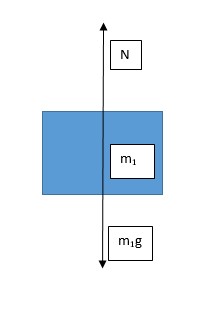block of mass m1 hangs from an ideal rope attached to a block of mass m2 which sits on an incline of angle φ. Friction is present between the ramp and m2. (a) Assume that initial neither block is moving. Draw a separate free body diagram for each mass. (b) If the blocks are not moving, what is the magnitude and direction of the force of static friction onm2? (c) If the block are not moving, what is the smallest possible value for the coefficient of static frictionμsbetween the ramp andm2?
A block of mass m1 hangs from an ideal rope attached to a block of mass m2 which sits on an incline of angle φ. Friction is present between the ramp and m2.
(a) Assume that initial neither block is moving. Draw a separate free body diagram for each mass.
(b) If the blocks are not moving, what is the magnitude and direction of the
(c) If the block are not moving, what is the smallest possible value for the coefficient of static frictionμsbetween the ramp andm2?

(a) Draw a separate free body diagram for each mass.
Free body diagram for m1
Diagram :

The forces acting on mass m1 are;
(1) Vertically downward force =F1=m1g (acted due to earth)
(2) Vertically upward force = Tension= T (Acted by a rope attached to mass)
As neither block is moving means, the system at rest; the forces add to zero.
T = m1g
Free body diagram for m2
Diagram :

The forces acting on mass m2 are;
(1) Vertically downward force m2g acted by the earth
(2) tension T along the rope on inclined ramp acted by rope
(3) Normal force N to the inclined ramp at an angle
Trending now
This is a popular solution!
Step by step
Solved in 3 steps with 2 images
